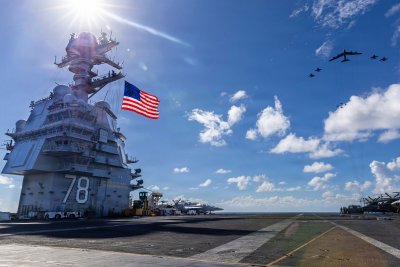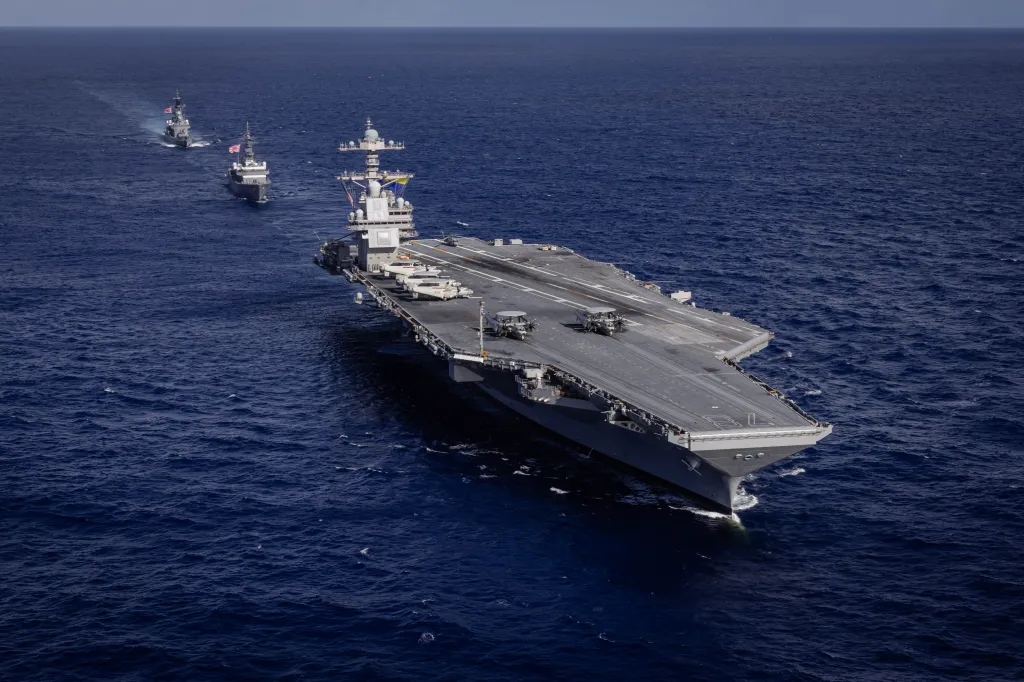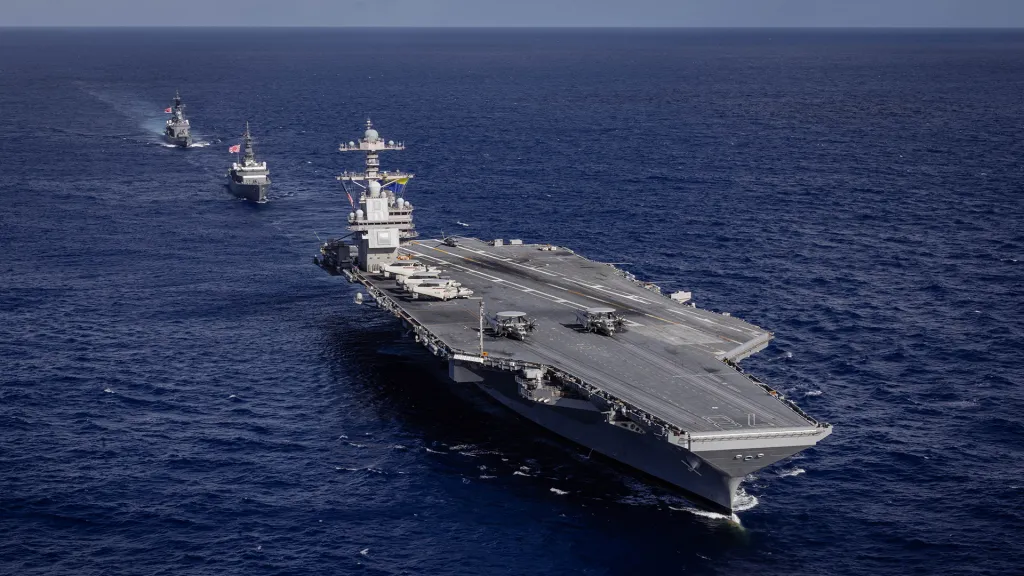Pressure On Maduro Cranked Up As USS Gerald R. Ford Arrives In Caribbean
The world’s largest aircraft carrier and its dozens of fighter aircraft are now in the Caribbean Sea, joining the largest U.S. military buildup in the region since the 1962 Cuban missile crisis. Meanwhile, the State Department announced Sunday that it plans to designate the drug cartel allegedly headed by Venezuelan dictator Nicolas Maduro as a Foreign Terrorist Organization (FTO) on Nov. 24, widening the aperture for potential military actions. These moves are the latest escalation of pressure on the South American leader, as the world awaits U.S. President Donald Trump’s decision on what, if any, further military actions he will take.
Sunday night, Trump appeared to offer a carrot to Maduro, saying he would be willing to open up a dialogue with the embattled Venezuelan leader.
“We may be having some discussions with Maduro,” Trump told reporters before boarding Air Force One in West Palm Beach. “They would like to talk… I talk to everybody.”
Trump did not elaborate; however, in private, he has talked to aides about Venezuela’s huge oil reserves, estimated at 300 billion barrels, the largest in the world, The New York Times claimed in a recent article. Trump has reportedly had an offer from Maduro that would give the U.S. rights to much of that oil in return for forestalling military action. While the American president called off those talks, a senior administration official told the Times that they were not entirely dead. The deployment of the aircraft carrier USS Gerald R. Ford and three of its escort ships, the official added, was a means to gain leverage over Maduro.

Trump on Sunday added that while he will notify Congress about what he will ultimately decide, he doesn’t need their permission to strike Venezuela.
“We’re stopping drugs from coming into our country,” the U.S. president continued. “I told [Secretary of State] Marco [Rubio] – go to Congress and let them know we’re not letting drugs come through Mexico, we’re not letting them come through Venezuela, and let Congress know about it. We don’t have to get their approval. But I think letting them know is good. The only thing I don’t want them to do is leak information… and they put our military at risk.”
On Sunday, the administration also announced two major sticks it could use against Maduro.
The Ford and its escorts – the Arleigh Burke class guided-missile destroyers USS Bainbridge, USS Mahan, and USS Winston S. Churchill (DDG 81) – arrived in the Caribbean, according to a Navy release. A U.S. official told The War Zone on Monday that the aircraft carrier was in the vicinity of Puerto Rico, which puts it roughly 700 miles north of the Venezuelan capital of Caracas and the epicenter of the military buildup in the region.
The Ford brings with it a great deal of additional capability to the newly named Joint Task Force Southern Spear, the enhanced counter-narcotics operation for which these forces have ostensibly been gathered. There are four squadrons of F/A-18 Super Hornets, a squadron of E/A-18 Growler electronic warfare jets, a squadron of E-2D Advanced Hawkeye airborne command and control aircraft, MH-60S and MH-60R Seahawk helicopters and a detachment of C-2A Greyhound carrier onboard delivery planes.

There were already seven Navy surface warships plus support vessels, a special operations mothership and aircraft, including F-35B stealth fighters, MQ-9 Reaper drones, P-8 wartime patrol aircraft, AC-130 Ghostrider gunships and about 15,000 U.S. personnel deployed to the region. Beyond that, there are “site surveys ongoing to see if even more military assets should be sent to the region,” a U.S. official told The War Zone on Nov. 7.

As the Navy highlighted that the Ford had crossed into the Caribbean, Rubio on Sunday announced that he “intends to designate Cartel de los Soles as a Foreign Terrorist Organization (FTO), effective November 24, 2025.”
“Based in Venezuela, the Cartel de los Soles is headed by Nicolás Maduro and other high-ranking individuals of the illegitimate Maduro regime who have corrupted Venezuela’s military, intelligence, legislature, and judiciary,” according to a State Department release. “Neither Maduro nor his cronies represent Venezuela’s legitimate government. Cartel de los Soles by and with other designated FTOs including Tren de Aragua and the Sinaloa Cartel are responsible for terrorist violence throughout our hemisphere as well as for trafficking drugs into the United States and Europe.”
Venezuelan political circles see the State Department’s move “as an ultimatum: a final window for Maduro to negotiate his exit or face what many see as the most serious U.S. threat to his rule to date,” The Miami Herald reported, “as the U.S. deploys the largest concentration of military assets in the Caribbean in decades.”
Trump on Sunday said designating Cartel de los Soles as a foreign terrorist organization allows the U.S. military authority to target Maduro’s assets and infrastructure inside Venezuela.
“It allows us to do that, but we haven’t said we’re going to do that,” Trump explained.
U.S. Rep. Carlos A. Gimenez, a Republican from Miami and fierce Maduro critic, lauded the State Department action.
“Remember that by designating the Cartel of the Suns as a foreign terrorist organization, it allows us to attack them militarily within the framework of U.S. law,” he stated on X. “Then they can’t say they weren’t warned. It’s almost over.”
While he said on Friday that he “sorta made up my mind” on what to do about Maduro, Trump appeared noncommittal on Sunday.
So far, U.S. kinetic actions against the cartels have been limited to strikes on alleged drug smuggling boats. On Nov. 15, the U.S. carried out the 22nd known attack, which combined have killed at least 80 people. The majority of those strikes were carried out by the MQ-9s and some by the AC-130 Ghostriders, as we have noted.
These attacks, however, have been criticized for being extrajudicial strikes without Congressional authorization. The administration has justified the strikes by declaring drug cartels to be “unlawful combatants,” and Trump has claimed, without proof, that each sunken boat has saved 25,000 American lives, presumably from overdoses.
If expanded strikes on land targets occur after the November 24th horizon, they could be limited to strictly cartel and drug production target sets that do not include state facilities. These could include labs, logistical nodes, such as port facilities, and cartel personnel. Striking military installations and other state infrastructure that the U.S. believes actively facilitate the drug trade would be a further escalation. Going directly after the Maduro regime and its military capabilities as a whole would be the farthest rung up the escalation ladder.
For his part, Maduro seems to be wavering between acquiescence and bravado.
On Nov. 15, Maduro sang John Lennon’s iconic peace anthem “Imagine” during a rally with supporters. Maduro urged calm, repeating “Peace, peace, peace” while government officials made peace signs on stage.

However, at the same rally, Maduro showed defiance, essentially telling the Trump administration to mind its own business.
“The U.S. wants to rule the world but ignores its own millions without housing, food, education, or battling addiction,” the Venezuelan strong man proclaimed. “They want to ‘save’ others with weapons. First, save yourselves; we know what to do with Venezuela.”
What will happen next is anyone’s guess. By law, Congress has seven days to review the State Department’s designation of Cartel de los Soles as an FTO. However, as we noted earlier in this story, Trump has hinted that he doesn’t need Congressional approval to attack Venezuela. In addition, it should be noted that Trump’s reported suggestions that potential adversaries want to talk are not necessarily a sign of impending calm.
On June 15, during the crisis about Iran’s nuclear weapons ambitions, Trump said Iran would “like to make a deal. They’re talking. They continue to talk,” adding that there was “no deadline” on the talks. Just six days later, the U.S. attacked three Iranian nuclear facilities in an operation dubbed Midnight Hammer.

As tensions in the Caribbean continue to simmer, we will provide updates when warranted.
Update 3:46 PM Eastern –
Speaking to reporters at the White House Monday afternoon, Trump was asked if he has ruled out putting U.S. troops in Venezuela.
“No, I don’t rule out that,” he answered. “I don’t rule out anything.”
Contact the author: [email protected]








